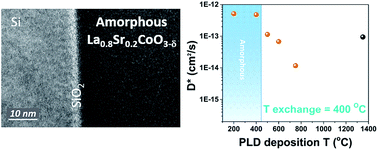当前位置:
X-MOL 学术
›
Sustain. Energy Fuels
›
论文详情
Our official English website, www.x-mol.net, welcomes your feedback! (Note: you will need to create a separate account there.)
Amorphous-cathode-route towards low temperature SOFC†
Sustainable Energy & Fuels ( IF 5.6 ) Pub Date : 2018-02-16 00:00:00 , DOI: 10.1039/c7se00606c Andrea Cavallaro 1, 2, 3, 4 , Stevin S. Pramana 4, 5, 6, 7 , Enrique Ruiz-Trejo 2, 3, 4, 8 , Peter C. Sherrell 1, 2, 3, 4 , Ecaterina Ware 1, 2, 3, 4 , John A. Kilner 1, 2, 3, 4, 9 , Stephen J. Skinner 1, 2, 3, 4
Sustainable Energy & Fuels ( IF 5.6 ) Pub Date : 2018-02-16 00:00:00 , DOI: 10.1039/c7se00606c Andrea Cavallaro 1, 2, 3, 4 , Stevin S. Pramana 4, 5, 6, 7 , Enrique Ruiz-Trejo 2, 3, 4, 8 , Peter C. Sherrell 1, 2, 3, 4 , Ecaterina Ware 1, 2, 3, 4 , John A. Kilner 1, 2, 3, 4, 9 , Stephen J. Skinner 1, 2, 3, 4
Affiliation

|
Lowering the operating temperature of solid oxide fuel cell (SOFC) devices is one of the major challenges limiting the industrial breakthrough of this technology. In this study we explore a novel approach to electrode preparation employing amorphous cathode materials. La0.8Sr0.2CoO3−δ dense films have been deposited at different temperatures using pulsed laser deposition on silicon substrates. Depending on the deposition temperature, textured polycrystalline or amorphous films have been obtained. Isotope exchange depth profiling experiments reveal that the oxygen diffusion coefficient of the amorphous film increased more than four times with respect to the crystalline materials and was accompanied by an increase of the surface exchange coefficient. No differences in the surface chemical composition between amorphous and crystalline samples were observed. Remarkably, even if the electronic conductivities measured by the Van Der Pauw method indicate that the conductivity of the amorphous material was reduced, the overall catalytic properties of the cathode itself were not affected. This finding suggests that the rate limiting step is the oxygen mobility and that the local electronic conductivity in the amorphous cathode surface is enough to preserve its catalytic properties. Different cathode materials have also been tested to prove the more general applicability of the amorphous-cathode route.
中文翻译:

通往低温SOFC的非晶阴极路线†
降低固体氧化物燃料电池(SOFC)器件的工作温度是限制该技术在工业上的突破的主要挑战之一。在这项研究中,我们探索了一种使用非晶态阴极材料制备电极的新方法。La 0.8 Sr 0.2 CoO 3− δ使用脉冲激光沉积在硅基板上已在不同的温度下沉积了致密膜。取决于沉积温度,已经获得纹理化的多晶或非晶膜。同位素交换深度分析实验表明,非晶膜的氧扩散系数相对于晶体材料增加了四倍以上,并且伴随着表面交换系数的增加。在非晶和结晶样品之间没有观察到表面化学组成的差异。值得注意的是,即使通过Van Der Pauw方法测得的电子电导率表明非晶态材料的电导率降低,阴极本身的总体催化性能也不会受到影响。该发现表明限速步骤是氧迁移率,并且非晶态阴极表面中的局部电子电导率足以保持其催化性能。还测试了不同的阴极材料,以证明非晶阴极路线的更普遍的适用性。
更新日期:2018-02-16
中文翻译:

通往低温SOFC的非晶阴极路线†
降低固体氧化物燃料电池(SOFC)器件的工作温度是限制该技术在工业上的突破的主要挑战之一。在这项研究中,我们探索了一种使用非晶态阴极材料制备电极的新方法。La 0.8 Sr 0.2 CoO 3− δ使用脉冲激光沉积在硅基板上已在不同的温度下沉积了致密膜。取决于沉积温度,已经获得纹理化的多晶或非晶膜。同位素交换深度分析实验表明,非晶膜的氧扩散系数相对于晶体材料增加了四倍以上,并且伴随着表面交换系数的增加。在非晶和结晶样品之间没有观察到表面化学组成的差异。值得注意的是,即使通过Van Der Pauw方法测得的电子电导率表明非晶态材料的电导率降低,阴极本身的总体催化性能也不会受到影响。该发现表明限速步骤是氧迁移率,并且非晶态阴极表面中的局部电子电导率足以保持其催化性能。还测试了不同的阴极材料,以证明非晶阴极路线的更普遍的适用性。



























 京公网安备 11010802027423号
京公网安备 11010802027423号